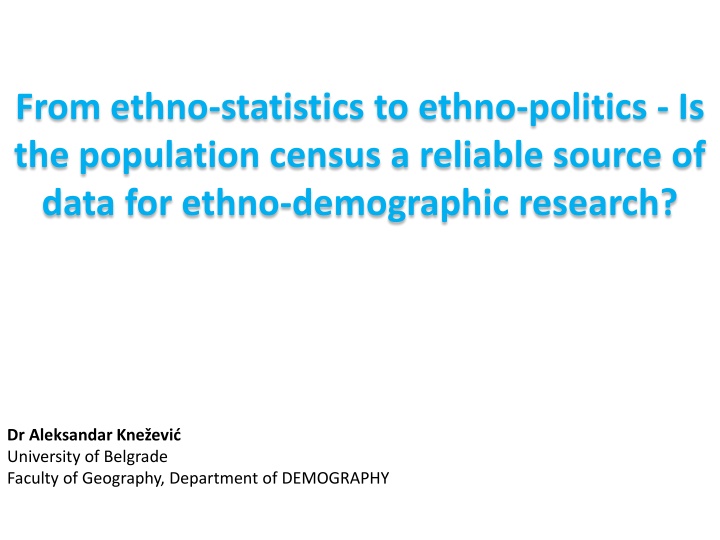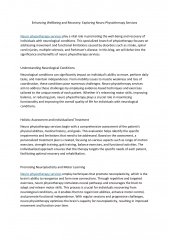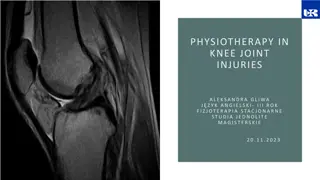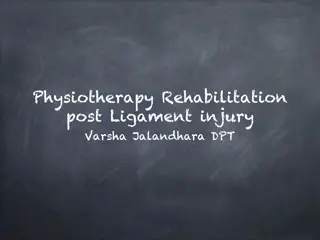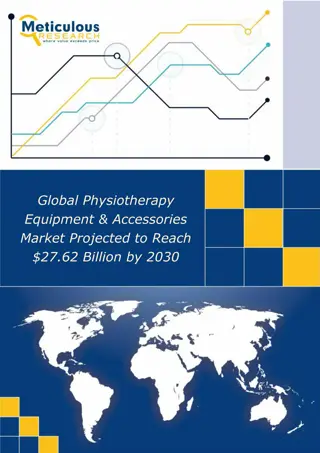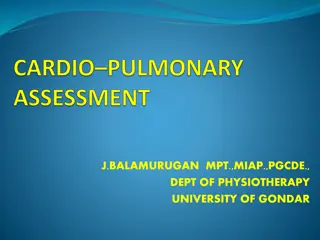Role of Physiotherapy in Orthopaedics
Physiotherapy, also known as physical therapy, plays a crucial role in evaluating, diagnosing, and treating various orthopedic conditions such as peri-arthritic shoulder, cervical spondylosis, sciatica, osteoarthritis, fractures, and more. This holistic approach involves using physical agents and exercises to help patients regain mobility, strength, and functionality in both inpatient and outpatient settings.
Download Presentation

Please find below an Image/Link to download the presentation.
The content on the website is provided AS IS for your information and personal use only. It may not be sold, licensed, or shared on other websites without obtaining consent from the author.If you encounter any issues during the download, it is possible that the publisher has removed the file from their server.
You are allowed to download the files provided on this website for personal or commercial use, subject to the condition that they are used lawfully. All files are the property of their respective owners.
The content on the website is provided AS IS for your information and personal use only. It may not be sold, licensed, or shared on other websites without obtaining consent from the author.
E N D
Presentation Transcript
From ethno-statistics to ethno-politics - Is the population census a reliable source of data for ethno-demographic research? Dr Aleksandar Kne evi University of Belgrade Faculty of Geography, Department of DEMOGRAPHY
Methodological problems of the Census ethno- statistic data 1. The influence of national policies An illusion of the ethnic monolithicity of the Kingdom of the SHS / Yugoslavia; Effect of the so-called new methodological solutions to ethnographic records to create new and unclear ethno-national modalities / identities; Politization of the censuses in the function of national counting and ethnic dispersion through targeted stratification of existing nationalities.
2.The impact of using the subjective criteria as the official principle of national identification The occurrence of ethnical dissimulation and ethnic transfer; Disagreement between real ethnic and declared nationality; The emergence of flotant ethnic groups in which variability is present in declaring their national, linguistic and religious identity; Expressed alterophony nationally declared (persons) in regard to mother tongue). (disproportion of
3. The problem of categorization of minorities ethnic minorities, national minorities, ethnic groups, nationalities, national groups (gradation in the function of ideological and political influence: nation-nationality-ethnic group)
1948 Srbi iptari Austrijanci 1953 Srbi iptari Austrijanci 1961 Srbi Albanci Austrijanci 1971 Srbi Albanci Austrijanci 1981 Srbi Albanci Austrijanci 1991 Srbi Albanci Austrijanci 2002 Srbi Albanci Austrijanci A kalije 2011 Srbi Albanci Austrijanci A kalije Banja i Belgijanci Bo njaci Bugari Bunjevci Vlasi Goranci Grci Danci Egip ani Englzi Italijani Jvreji Jermeni Jugosloveni Kinezi Ma ari Makedonci Muslimani Nemci Norve ani Poljaci Romi Rumuni Rusi Rusini Slovaci Slovenci Torlaci Turci Ukrajinci Finci Francuzi Hrvati Cincari Crnogorci esi vajcarci ve ani okci opi Ostali Neizja njeni Reginalni Nepoznato Belgijanci Belgijanci Bo njaci Bugari Bunjevci Vlasi Goranci Grci Danci Egip ani Englzi Italijani Jvreji Bugari Bugari Bugari Bugari Bugari Bugari Bunjevci Vlasi Vlasi Vlasi Vlasi Vlasi Vlasi Grci Grci Grci Grci Grci Grci Danci Egip ani Englzi Italijani Jvreji Italijani Jvreji Italijani Jvreji Italijani Jvreji Italijani Jvreji Italijani Jvreji Jugosloveni-neopred Jugosloveni-neopred Jugosloveni Jugosloveni Jugosloveni Jugosloveni Kinezi Ma ari Makedonci Muslimani Nemci Norve ani Poljaci Romi Rumuni Rusi Rusini Slovaci Slovenci Ma ari Makedonci Musl-neopr Nemci Ma ari Makedonci Jug-neopred Nemci Ma ari Makedonci Musl etn pr Nemci Ma ari Makedonci Muslimani Nemci Ma ari Makedonci Muslimani Nemci Ma ari Makedonci Muslimani Nemci Norve ani Poljaci Romi Rumuni Rusi Rusini Slovaci Slovenci Poljaci Cigani Rumuni Rusi Rusini/Ukrajinci Slovaci Slovenci Poljaci Cigani Rumuni Rusi Rusini/Ukrajinci Slovaci Slovenci Poljaci Cigani Rumuni Rusi Ru/Uk/Rut/eniMalorusi Slovaci Slovenci Poljaci Romi-Cigani Rumuni Rusi Rusini Slovaci Slovenci Poljaci Romi Rumuni Rusi Rusini Slovaci Slovenci Turci Turci Turci Turci Ukrajinci Turci Ukrajinci Turci Ukrajinci Turci Ukrajinci Finci Francuzi Hrvati Cincari Crnogorci esi vajcarci ve ani okci Francuzi Hrvati Francuzi Hrvati Hrvati Hrvati Hrvati Hrvati Crnogorci esi Crnogorci esi Crnogorci esi Crnogorci esi Crnogorci esi Crnogorci esi vajcarci ve ani okci Ostali Ostali Nac neopredeljeni Ostali Nac neopredeljeni Ostali Neizja njeni Reginalni Nepoznato Ostali Neizja njeni Reginalni Nepoznato Ostali Neizja njeni Reginalni Nepoznato Ostali Neizja njeni Reginalni Nepoznato Nep narodno Nepoznato Nepoznato
Population of the Republic of Serbia according to declared nationality, 19482011. 19911) 7759920 6252405 15406 / / 26698 21434 17804 / 916 433 1107 / 320168 343800 45068 180222 5172 94492 42316 2473 18052 66772 8001 765 5042 97344 / 118934 2675 1738 / 7166 10718 4841 47958 20021) 7498001 6212838 61647 584 136087 20497 20012 40054 4581 572 814 1158 / 80721 293299 25047 19503 3901 108103 34576 2588 15905 59021 5104 522 5354 70602 293 69049 2211 717 / 7051 107732 11485 75483 20111) 7186862 5988150 5809 997 145278 18543 16706 35330 7767 725 1834 787 222 23303 253899 22755 22301 4064 147604 29332 3247 14246 52750 4033 647 4903 57900 243 38527 1824 607 142 9530 160346 30771 81740 1948 6527966 4823730 532011 / / 59472 / 93440 / / / / / / 433701 17917 17315 41460 52181 63160 13329 22667 73140 20998 1914 / 169864 / 74860 6760 / / 9214 / / / 1953 6979154 5152939 565513 / / 60146 / 28047 / 1279 / 1054 / / 441907 27277 81081 46228 58800 59705 7829 23720 75027 20717 54526 / 173246 / 86061 5948 / / 7807 / / 1994 1961 7642227 5704686 699772 / / 58494 / 1368 / 1178 / 1250 / 20079 449587 36288 93467 14533 9826 59505 6984 25658 77837 19957 44434 / 196409 / 104753 5133 / / 7267 / / 5604 1971 8446591 6016811 984761 / / 53800 / 14724 / 840 / 1128 / 123824 430314 42675 154330 9086 49894 57419 4746 20608 76733 15957 18220 5643 184913 / 125560 4149 / / 6989 4486 10409 30274 1981 9313677 6182159 1303032 / / 33455 / 25596 / 757 / 683 / 441941 390468 48986 215166 5302 110959 53693 2761 19757 73207 12006 13890 5520 149368 / 147466 3225 / / 17289 7834 6848 43222 UKUPNO Serbians Albanians3) Ashkali Bosniaks Bulgarians Bunjevci4) Vlachs Gorani Greeks5) Egyptians Jews5) Armenians Yugoslavs6) Hungarians Macedonians Muslims Germans Roma Romanians Russians Rusyns2) Slovaks Slovenians Turks Ukrainians2) Croatians4) Cincar Montenegrins Czechs Sochs4) Shopi Others Undeclared Regional Unknown Notes: 1) No data for AP Kosovo and Metohija; 2) Before the 1971. census, the Ukrainians and the Rusynswere presented collectively; 3) the incomplete coverage of the 1991. and 2011. censuses in the Pre evo, Bujanovac and Medve a municipalities due to the boycott of the Albanian population; 4) Before the 1991 census, the Bunjevci and okci were presented collectively with the Croats ; 5) In the 1948 census, the FNR Yugoslavia recorded a total of 6,853 Jews and 1830 Greeks who were not specifically mentioned by republics but were classified into the category of others;6)In the census of 1961, the Yugoslav modality includes citizens who did not declare their nationality or declare their regional affiliation;
Growth Index of Serbian population according to declared nationality, 19482011. 1953/48 106,9 106,8 106,3 / / 101,1 / 30,01 / / / / / 101,9 152,2 468,3 111,5 112,7 94,5 58,7 104,6 102,6 98,7 / 2848,8 102,0 / 115,0 / 88,0 1961/53 109,5 110,7 123,7 / / 97,3 / 4,9 / 92,1 / 118,6 / 101,7 133,0 115,3 31,4 16,7 99,7 89,2 108,2 103,7 96,3 / 81,5 113,4 / 121,7 / 86,3 1971/61 110,5 105,5 140,7 / 1981/71 110,3 102,7 132,3 / / 62,2 / 173,8 / 90,1 1991/81 83,3 101,1 1,2 / / 79,8 / 69,6 / 121,0 / 162,1 72,4 88,0 92,0 83,8 97,5 85,2 78,8 89,6 91,4 91,2 66,6 91,3 5,5 65,2 / 80,7 / 82,9 2002/91 96,6 99,4 400,1 / / 76,8 93,4 225,0 / 62,4 188,0 104,7 25,3 85,4 55,6 10,8 75,4 114,4 81,7 104,6 88,1 88,4 63,8 106,2 68,2 72,5 / 58,1 41,3 82,7 2011/02 95,9 96,4 9,4 170,7 106,8 90,5 83,5 88,2 169,5 126,7 225,3 68,0 28,9 86,6 90,8 114,3 104,2 136,5 84,8 125,5 89,6 89,4 79,0 91,6 123,9 82,0 82,9 55,8 84,7 82,5 TOTAL Serbians Albanians Aschali Bosniaks Bulgarians Bunjevci Vlachs Gorani Greeks Egiptians Jews Yugoslavs Hungarians Macedonians Muslims Germans Roma Romanians Russians Rusyns Slovaks Slovenians Ukrainians Turks Croatians Cincar Montenegrines Sochs Czechs 92,0 1076,3 71,3 / 90,2 616,7 95,7 117,6 165,1 62,5 507,8 96,5 68,0 80,3 98,6 80,0 / 41,0 94,1 60,5 356,9 90,7 114,8 139,4 58,35 222,4 93,5 58,2 95,9 95,4 75,2 97,8 76,2 80,8 / 117,4 / 77,7 119,9 / 80,8
The result of hierarchical cluster analysis (Ward Linkage method) to the original data of the growth index of the population of Serbia, according to declared nationality A model of the square euclidean distance was used to measure the similarity of the variation
Cluster affiliation of ethnic groups, according to growth index in the multiple choice clusters 5 clusters Serbians 1 Albanians 2 Bulgarians 1 Vlachs 3 Greeks 1 Jews 1 Yugoslavs 4 Hungarians 1 Macedonians 1 Muslims/Bosniaks 1 Germans 1 Roma 5 Romanians 1 Russians 1 Rusyns/Ukrainians 1 Slovaks 1 Slovenians 1 Turks 1 Croatians/Bunjevci/Sochs 1 Montenegrines 1 Czechs 1 4 clusters 1 2 1 3 1 1 4 1 1 1 1 4 1 1 1 1 1 1 1 1 1 3 clusters 1 1 1 2 1 1 3 1 1 1 1 3 1 1 1 1 1 1 1 1 1 2 clusters 1 1 1 2 1 1 2 1 1 1 1 2 1 1 1 1 1 1 1 1 1
The standard deviation of the growth index by declared nationality, 19482011. StDev 10,3 1052,4 377,6 260,9 160,7 145,8 132,2 37,1 31,7 30,7 29,8 28,8 26,4 StDev 25,8 25,0 16,9 13,5 13,4 9,7 8,1 7,0 7,0 7,0 6,2 4,8 3,4 TOTAL Turci /Turks) Vlasi /Vlachs Jugosloveni /Yugoslavs Romi/Roma Muslimani/Muslims Albanci/Albanians Jevreji/Jews Makedonci/Macedonians okci/Sokcs Crnogorci/Montenegrins Nemci/Germans Egip ani/Egiptians Grci/Greeks Rusi/Russians Hrvati/Croatians Bugari/Bulgarians Slovenci/Slovenians Rusini/Rusyns Rumuni/Romanians Bunjevci/Bunjevci Ukrajinci/Ukrainians Ma ari/Hungarians Slovaci/Slovaks Srbi/Serbs esi/Czehcs 1200.00 1000.00 800.00 600.00 400.00 200.00 0.00
The number of declared Germans, Turks, Yugoslavs and Montenegrins in Serbia, 19482011. Germans Turks 60000 50000 45000 50000 40000 35000 40000 30000 25000 30000 20000 20000 15000 10000 10000 5000 0 0 1948 1953 1961 1971 1981 1991 2002 2011 1948 1953 1961 1971 1981 1991 2002 2011 Yugoslavs Montenegrins 160000 450000 400000 140000 350000 120000 300000 100000 250000 80000 200000 60000 150000 40000 100000 20000 50000 0 0 1948 1953 1961 1971 1981 1991 2002 2011 1948 1953 1961 1971 1981 1991 2002 2011
The number of declared Vlachs and Roma in Serbia, 19482011. Vlachs Roma 100000 160000 93440 147604 140237 90000 140000 80000 120000 110959 108103 70000 100000 60000 50000 80000 40054 40000 35330 58800 60000 52181 49894 28047 25596 30000 40000 17807 20000 14724 20000 10000 9826 1368 0 0 1948 1953 1961 1971 1981 1991 2002 2011 1948 1953 1961 1971 1981 1991 2002 2011
Nanural increase (J) and the absolute growth (R) of selected varying ethnic groups in Serbia, 2002 2011. J R Albanians 7892 -55838 Montenegrins -2139 -30522 Yugoslavs 383 -57418 Germans -812 163 Roma 21301 39501 Vlachs -525 -4724 Source: Demographic statistics and Census data (1971-2011), SZS and RZS, Belgrade.
Nanural increase (J) and the absolute growth (R) of Vlachs in Serbia, 19702010. N M J R -4 1971-1980 8 12 10760 -131 1981-1990 17 148 7810 -296 1991-2001 101 397 22536 -488 2002-2010 53 541 4550 1971-2010 179 1098 -919 21029 Source: Demographic statistics and Census data (1971-2011), SZS and RZS, Belgrade.
